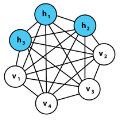Graph clustering is the process of grouping vertices into densely connected sets called clusters. We tailor two mathematical programming formulations from the literature, to this problem. In doing so, we obtain a heuristic approximation to the intra-cluster density maximization problem. We use two variations of a Boltzmann machine heuristic to obtain numerical solutions. For benchmarking purposes, we compare solution quality and computational performances to those obtained using a commercial solver, Gurobi. We also compare clustering quality to the clusters obtained using the popular Louvain modularity maximization method. Our initial results clearly demonstrate the superiority of our problem formulations. They also establish the superiority of the Boltzmann machine over the traditional exact solver. In the case of smaller less complex graphs, Boltzmann machines provide the same solutions as Gurobi, but with solution times that are orders of magnitude lower. In the case of larger and more complex graphs, Gurobi fails to return meaningful results within a reasonable time frame. Finally, we also note that both our clustering formulations, the distance minimization and $K$-medoids, yield clusters of superior quality to those obtained with the Louvain algorithm.
翻译:图形群集是将脊椎分组为密连的群集的过程。 我们从文献中为这一问题定制了两种数学编程配方。 这样, 我们就能从中找到一个对集群内密度最大化问题的超光速近似值。 我们用布尔茨曼机器的两种变式来获得数字解决方案。 为了基准, 我们比较解决方案质量和计算性能与使用商业求解器( Gurobi) 获得的数值。 我们还将组合质量与使用流行的 Louvain 模块化最大化方法获得的群集质量进行比较。 我们的初步结果清楚地表明了我们的问题配方的优势。 他们还建立了波尔茨曼机器在传统精确解答器上的优势。 在较不复杂的图形中, 博尔茨曼机器提供了与 Gurobi 相同的解决方案, 但解算时间的大小却较低。 在较大和更加复杂的图形中, 古罗比无法在合理的时间框架内返回有意义的结果 。 最后, 我们还注意到, 我们的组合配方、 距离最小化和 $K$- mids, 都产生优于Louvain 算法获得的高级质量组。



